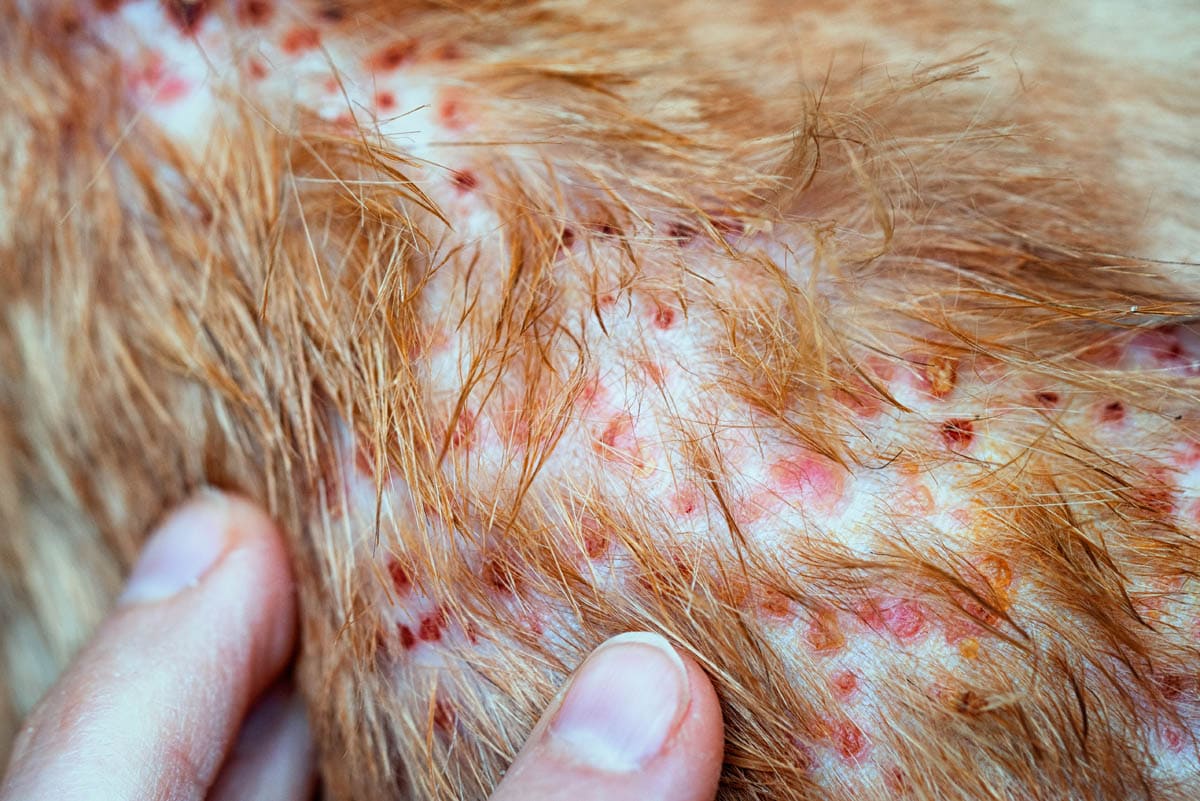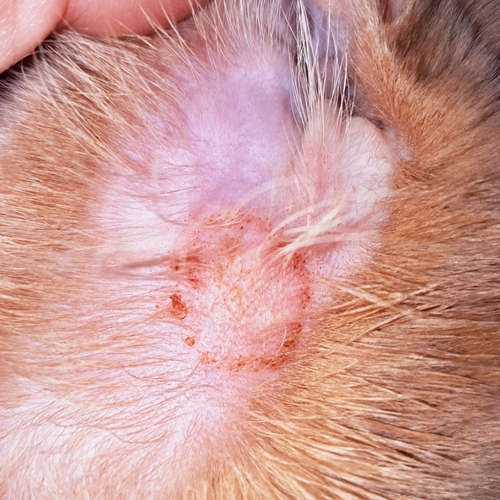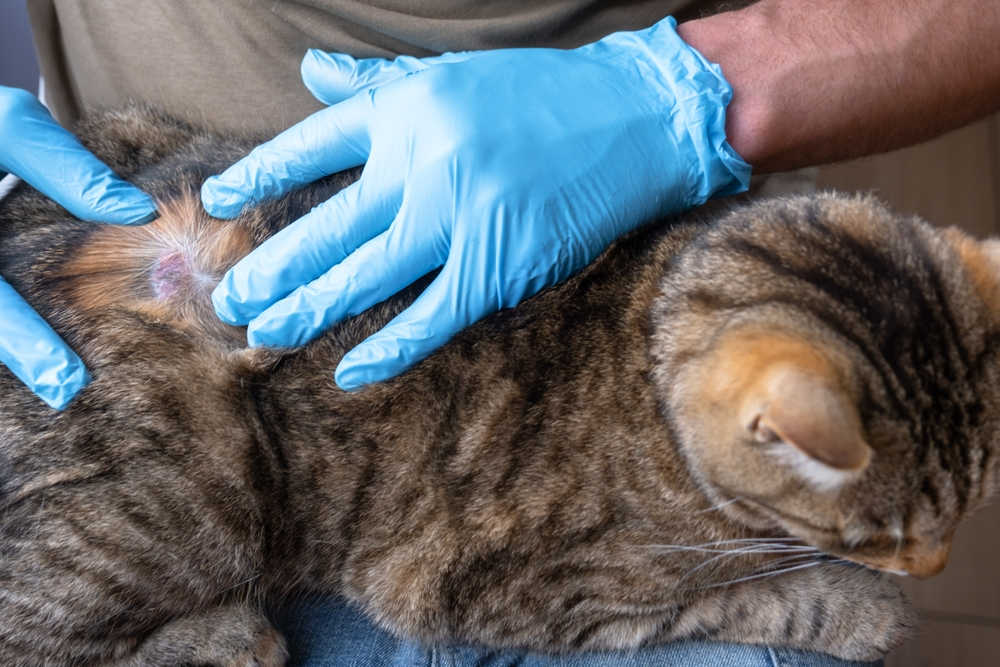For any doting cat owner, noticing sores or hair loss on their beloved feline can be upsetting. Skin problems are among the most common medical issues I’ve seen in private practice as a veterinarian, and they can be attributed to various causes. Some conditions cause hair loss and sores from self-trauma due to itching and discomfort, while others damage hair follicles directly. Let’s take a closer look at common causes and what pet parents can do.
Common Causes of Sores and Hair Loss in Cats
1. Allergies
Cats, like their human companions, can suffer from various allergies. One of the most common is Flea allergy dermatitis (FAD), an allergic reaction to flea bites. This often manifests as miliary dermatitis, characterized by small, crusty bumps and sores, primarily along the cat’s neck and back (see picture below). Besides FAD, certain foods or ingredients can cause skin reactions and, in some cases, gastrointestinal upset. Also, environmental allergens such as pollen or dust might be at play.
Regardless of the underlying cause, allergies cause hair loss and signs of secondary skin infections in cats. Treatment usually involves consistent flea prevention, feeding a hydrolyzed protein or limited ingredient diet for food allergies, and medications and lifestyle changes to help manage environmental allergies. Secondary infections must also be treated with oral or topical antibiotics. Learn more about allergies in cats (including food allergies).
Below is an image of miliary dermatitis:

2. Parasitic Infections
Fleas, the primary instigator of FAD, can make any cat scratch incessantly. Mites, especially types like Demodex or ear mites, also lead to hair loss, skin irritations, and secondary infections. And don’t be misled by ringworm – it’s a highly contagious fungal infection, not a worm, causing skin lesions and hair loss.
Once your veterinarian has identified the specific cause, they will be able to recommend a treatment plan, which may involve oral and topical medications. Flea and parasite prevention comes in a variety of forms and typically needs to be used monthly.
Below is an image of ringworm in cat. While its name might suggest circular lesions, which are indeed a common presentation, ringworm can also appear as irregular patches of hair loss, with associated redness and scaling. Some affected cats might display broken or brittle hairs within these patches. Some cases will glow a bright apple-green color when exposed to a Wood’s lamp, a type of ultraviolet light used by veterinarians. View more pictures and information about ringworm in cats.

3. Skin Infections
Bacterial, yeast, and fungal infections can cause hair loss associated with pus-filled sores, scabby skin, flakes, oozing, and crusty patches. Infections are often caused by injury, self-trauma, or another underlying condition such as allergies or endocrine disease. Treatment will involve topical or oral medications to treat the infection. In chronic or recurrent cases identification and management of the underlying cause is also critical.
Skin infections can vary significantly in appearance and severity, as pictured below. Learn more about skin infections in cats.


4. Systemic disease
Conditions like Pemphigus complex, endocrine disease, or cancer can sometimes affect the skin and fur coat as well. Treatment will vary.
5. Stress and Behavioral Issues
Stress isn’t just a human problem. Cats can over-groom due to stress or anxiety, leading to noticeable hair loss, skin irritation, and secondary infections. Cats can also overgroom certain areas that are painful, for example, over joints that are affected by arthritis. Treatment may involve a combination of supplements, medications, and environmental modification to help decrease anxiety and manage pain. Learn more about signs of stress in cats.
Symptoms and Diagnosis
Beyond sores or bald patches, symptoms like itchy skin (pruritus), frequent scratching/chewing/biting, redness, or behavioral changes indicate a vet visit is in order. Diagnostic tests such as skin cytology, skin scrapings, bacterial or fungal cultures, and blood tests can help pinpoint the issue.
General Care and Treatment Options for Cat Hair Loss and Sores
Treatment depends on the underlying cause but frequently includes:
- Topical Treatments: Medicated shampoos, ointments, or flea treatments might be in the cards, depending on the diagnosis.
- Systemic Treatments: Oral antibiotics or antifungals can combat infections. Allergies might warrant a dietary change. Corticosteroids can help decrease itch and inflammation.
- Behavioral and Environmental Changes: To counter stress, try providing enrichment such as new toys, places to perch, and scratching posts. Pheromone sprays can soothe anxious cats. In some cases, stronger behavioral medications may be indicated.
- Dermatologist Referral: Hair loss and sores can be extremely frustrating for cats and their pet parents alike. Referral to a dermatologist is always an option in complex cases.
Preventive Measures
To ensure your cat’s prime condition:
- Regular Grooming: Besides detecting skin issues early, brushing minimizes hairballs.
- Flea and Tick Prevention: Monthly treatments can keep these pests away.
- Proper Nutrition: An AAFCO and WSAVA-approved diet promotes a healthy coat and skin.
- Supplements: Supplements such as omega-3 fatty acids (found in fish oil) and probiotics can help promote skin and immune system health.
- Vet Check-ups: Routine visits can preempt major issues.
- Consider a Cone: If you notice hair loss and scabs on your cat but can’t get into the vet for a few days, an E-collar can help prevent chewing/licking leading to additional damage.
Your cat’s skin health often mirrors their overall health. Being observant and working closely with your veterinarian ensures your feline friend remains healthy and vibrant. So, during those cuddling sessions, give your cat a once-over. Your purring companion will be grateful!

